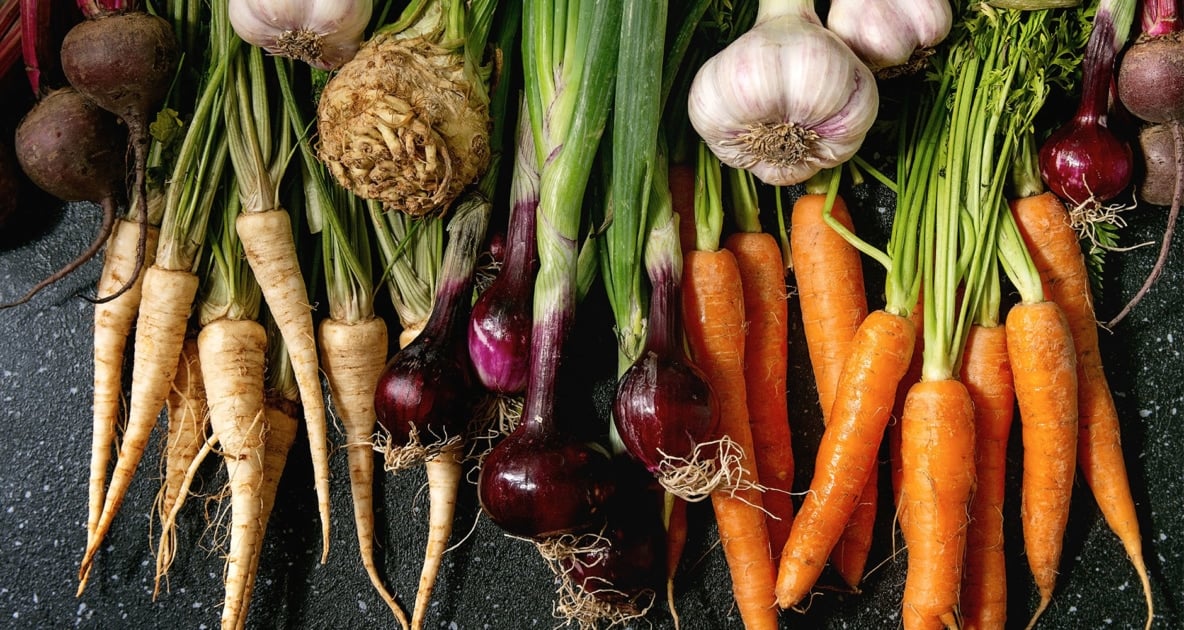How to Store Root Vegetables, without a root cellar
Storing your root vegetables using the sand method allows you to put delicious, quality produce on the table until spring—no root cellar needed!

Did you have a successful garden this year? Many of our readers have reported growing plentiful crops of carrots, turnips, potatoes, and other root vegetables. However, using them up can be quite a challenge. So how do you store root vegetables? Some root vegetables like carrots can be stored right in the garden over the winter by simply covering them with a thick layer of mulch. However, this method may not be very convenient. On the other hand, storing root vegetables in sand indoors not only offers an efficient solution to reduce waste, but it also helps in conserving energy, saving money, and providing delicious, high-quality produce for months to come—completely eliminating the need for a root cellar!
Which Fresh Root Vegetables and Fruits Store Well in Sand?
Vegetables that store exceptionally well in sand are turnips, beets, rutabaga, carrots, parsnips, salsify, ginger, onions, and winter radishes. Firm fleshed fruits such as apples and pears also keep well in sand.
The Basics of Storing Root Vegetables in Sand
- Temperature. Root crops require cold and moisture when stored in sand. They are best stored at a temperature of 32 to 40° F. with 90 to 95 percent relative humidity. High humidity helps keep carrots and other vegetables from shriveling. Apples and pears require the same cold temperatures with a relative humidity of 80-90 percent.
- Container. Use cardboard or wood boxes placed off the ground on pallets. The crisper drawer in the refrigerator also easily transforms into a mini root cellar. Plastic storage bins also work.
- Location, location: In the book, Root Cellaring, authors Mike and Nancy Bubel advise, “All you need …is a 3.5′ x 7′ space. It will hold 28 half-bushels of produce.” The room you store your veggies in will need to be unheated, enclosed, and well insulated. If you have a basement, a corner or a closet can easily be converted into a root cellar. If you don’t have a basement, you can use an interior corner of an unheated garage or storage shed during the cooler months, as long as the temperature does not drop below freezing.
- Type of sand.Once you have chosen a suitable location to store your root vegetables, you will need “play” sand to pack the harvested vegetables. Play sand is a fine-grade sand that has been washed, dried, and screened. This type of sand is commonly used in children’s sandboxes and landscaping projects. It is usually available in 50 lbs. bags at local garden and home improvement stores. Play sand is typically slightly damp, but not soggy. If it is not damp enough, you can add some sand to a bucket, moisten it with a spray bottle of distilled water, and evenly distribute the moisture by tossing the sand with your hands before packing the root vegetables. The sand helps preserve freshness and prevents rot by keeping excess moisture away from the vegetables.
Procedure for Sand Storage
- Remove the leafy tops of vegetables before storing them, but don’t clean or wash the root vegetables prior to storage. Let them sit in the air for a couple of days prior to storage to let the skins “cure.”
- Select the best of the crop—mature, but not overripe, unbruised, and unblemished produce.
- Pour a layer of sand, several inches deep, into your storage container. Work your fruit or vegetables into the sand, adding more sand and vegetables in layers, making sure the sand covers the vegetables being stored, and allow for space between the vegetables.
Storage Notes
- Store carrots and parsnips vertically in the sand, making sure they do not touch each other.
- Avoid storing apples and root vegetables together. Apples release ethylene gas, which can speed up the ripening process and cause your root vegetables to rot.
- If your storage room is dry, check the sand regularly and add moisture as needed to prevent it from drying out. One way to do this is by spraying the sand with distilled water when necessary.
- Check stored food every week or so, culling those veggies showing signs of deterioration.
- In general, root crops can remain fresh in sand for two to five months.
- Remember, the vegetables are stored to eat through the winter months, So, eat them before signs of spoilage appear.
- When you’re ready to eat your vegetables, remove the desired quantity, dust the sand off, and clean thoroughly before preparing.
Be sure to check our Gardening by the Moon calendar for the best days to plant and harvest!
Related
15 Ways to store your garden harvest

Deborah Tukua
Deborah Tukua is a natural living, healthy lifestyle writer and author of 7 non-fiction books, including Pearls of Garden Wisdom: Time-Saving Tips and Techniques from a Country Home, Pearls of Country Wisdom: Hints from a Small Town on Keeping Garden and Home, and Naturally Sweet Blender Treats. Tukua has been a writer for the Farmers' Almanac since 2004.






We’re using a plastic bin in our cold garage. We don’t want to attract mice, so we have the lid on. Is that ok? Should we periodically air it out?
Can I reuse the sand the following winter?